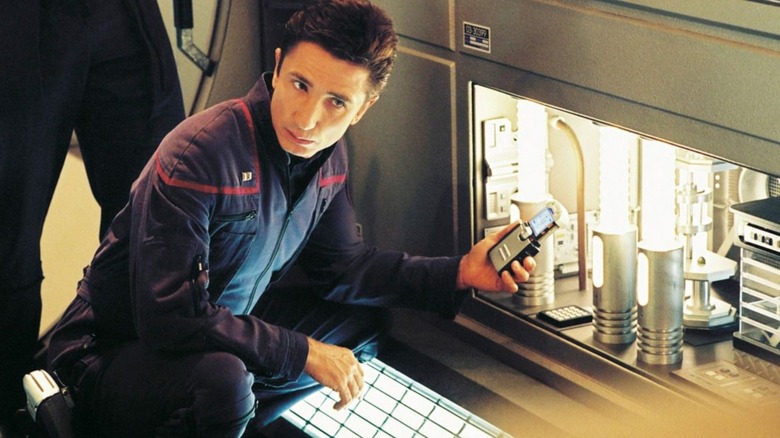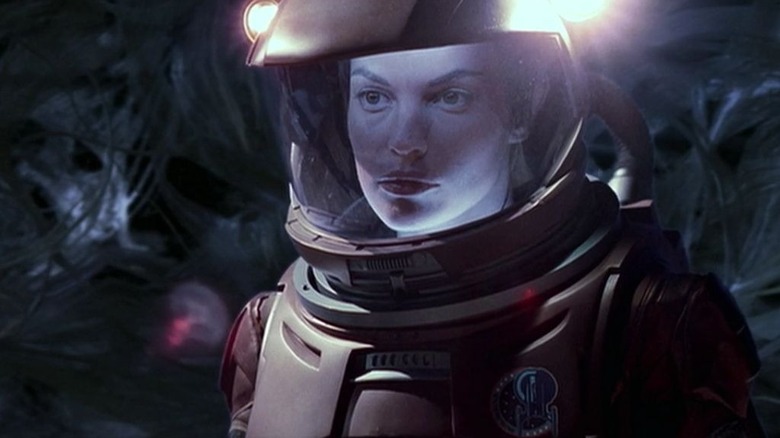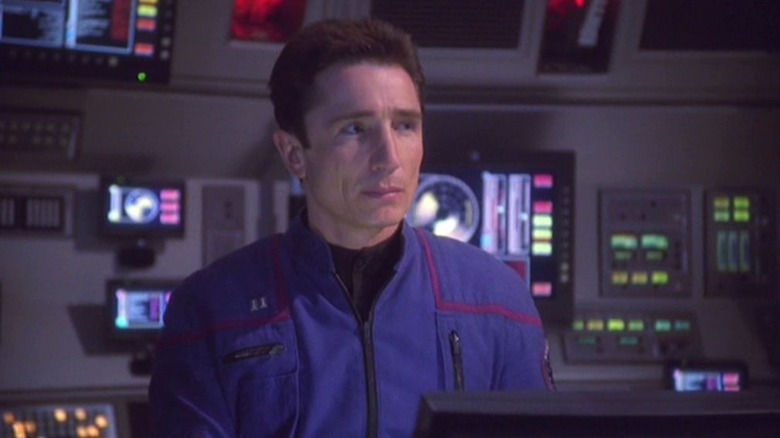The Spacesuits In Star Trek: Enterprise Put A Brutal Strain On The Series' Stars
The uniforms on the original "Star Trek" might be some of the most casual, comfy military kits ever seen. Captain Kirk (William Shatner) essentially wore a lightweight, tight-fitting long-sleeve t-shirt, a pair of black slacks, and some versatile patent leather shoes. Apart from his department color — the gold hue indicated his status as a command officer — and the rank stripes around his wrists, the uniform didn't seem to have any additional practical functions. It didn't have pockets, so communicators and tricorders needed to be carried as accessories.
One might assume that "Star Trek" uniforms were made from an ultra-advanced, super-breathable material that allowed its wearer to have a more evenly regulated body temperature, but that is mere headcanon; such details were never revealed on the show. It also wouldn't be true for the Enterprise's female crew members who were typically seen in minidress uniforms and black leggings.
Trek uniforms only got more uncomfortable-looking from there. The movies saw Kirk and Co. in red uniforms as thick as Christmas sweaters, and "Next Generation," "Deep Space Nine," and "Voyager" all featured ill-fitting jumpsuits that constantly needed readjusting. Also, if they were jumpsuits, did one have to strip all the way down to use the bathroom while on duty?
A happy medium was finally reached with the uniforms on "Star Trek: Enterprise," a show set a century prior to "Star Trek." They were still jumpsuits, but they finally looked comfortable, functional, and had many, many pockets. Very NASA.
But there were still a few costume issues. In the invaluable oral history book "The Fifty-Year Mission: The Next 25 Years: From The Next Generation to J. J. Abrams." edited by Mark A. Altman and Edward Gross, "Enterprise" actor Dominic Keating pointed out that the show's high-tech space suits were massively heavy.
Star Trek by way of NASA
The costume designers on "Enterprise" were clearly aiming for a midpoint between modern 21st-century NASA space suits and 23rd-century Captain Kirk uniforms. The "Star Trek" department colors were present on the "Enterprise" jumpsuits, but as mere colored shoulder accents. Otherwise, most characters wore all blue. The Vulcan first officer T'Pol (Jolene Blalock) was given textured, form-fitting catsuits to wear. Because of the lascivious underpinnings of the show, audiences also learned that everyone wore loosely draped, lightweight grey underwear with no support.
But the space suits were the biggest issue for the cast. To add to the NASA textures of the show, characters were frequently seen in astronaut outfits, complete with helmets and massive gloves. According to Keating, those space suits were heavy, which became a problem when an actor has to shoot all day long. He explained:
"The sets, the effects, the camera stuff is so much more difficult, which for the actor translates to a lot more hours, many more takes, and so on. The spacesuits look great, but, my god, they are heavy. I'm strong. I pitied the female cast members. You carry around a five-pound bucket of water for a couple of hours. The helmets alone are 16 pounds and they're not connected to the bodysuit, so it's your neck that's carrying that thing."
When Kirk wore a spacesuit, it looked awkward but was at least made of lightweight material, like mosquito netting. One might wonder why Starfleet didn't continue using personal force fields as space suits, as seen in "Star Trek: The Animated Series." That seemed to be the most comfortable option. But then, personal force fields would require a pretty massive power source, so perhaps they proved too unreliable.
Bearing the weight of being a Starfleet officer
Keating had to rely on some special self-calming techniques to get through the shooting day wearing his space suit. He said:
"I do yoga, so in the claustrophobia of the suit, I would sit down and just close my eyes and go into an almost transcendental state until I heard the bell when you have to stand up again."
Luckily, scenes in the space suits were few and far between on "Enterprise," and characters mostly got to wear the blue jumpsuits.
For "Star Trek: Discovery," the approach to designing the space suits was just as concerned with functionality as aesthetics, and a lot of effort went into making them resemble how space suits might actually look in the future. Those suits were built for long-term interstellar use and featured lights, thrusters, and multiple tools that can be used in a vacuum. The costumes were also made of lighter materials than the "Enterprise" suits, so actors were likely more comfortable in them.
An issue that savvy viewers might notice, however, is that most helmeted space suits in movies and on TV feature special in-helmet lighting to illuminate the actors' faces. While these miniature lights can assure a clear shot and visible acting, they don't make any sense from a practical, in-universe standpoint. It would be terribly difficult to do one's job in space if one constantly has multiple tiny LED lights shining directly in their eyes.
But the facial lighting is one of those dramatic sci-fi conceits — like artificial gravity or universal translators — that Trekkies merely have to come to accept.


